What is a feral cat colony?
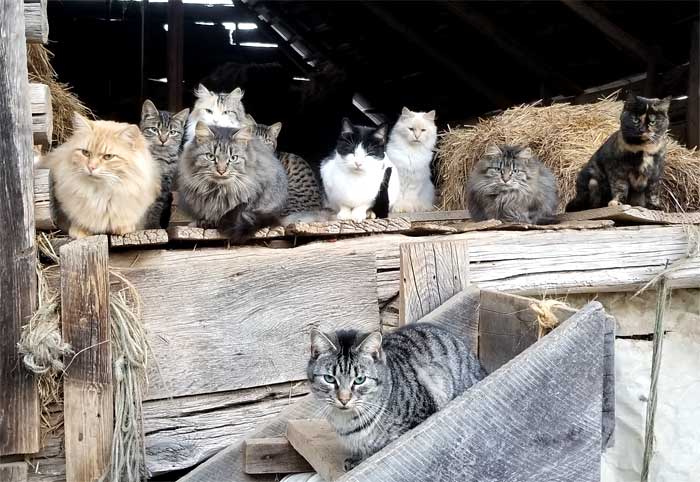
Ten of the Payne Colony Cats - photos by Janice
Boling
An established group of feral cats is called a feral cat colony. Colonies can be managed or unmanaged by humans. Feral cats live a wild life, but are still considered domesticated cats. They do not show affection to people, although they might tolerate the presence of the person that feeds them.
Can feral cats become pets?
Feral cats can't be petted or picked up because they are afraid of humans. They have never been socialized. Most feral cats will never become pets.
If you corner a feral cat and try to touch it, it will hiss, scratch, and bite. Most feral cats have sharp claws and teeth which they do not hesitate to use when feeling threatened.
Feral cats can survive outdoors on their own.
They can find their own meals and are happy with a mouse from the meadow or meat scraps from a garbage can. Most feral cats do fine without human interference as long as wild game or another food source is available.
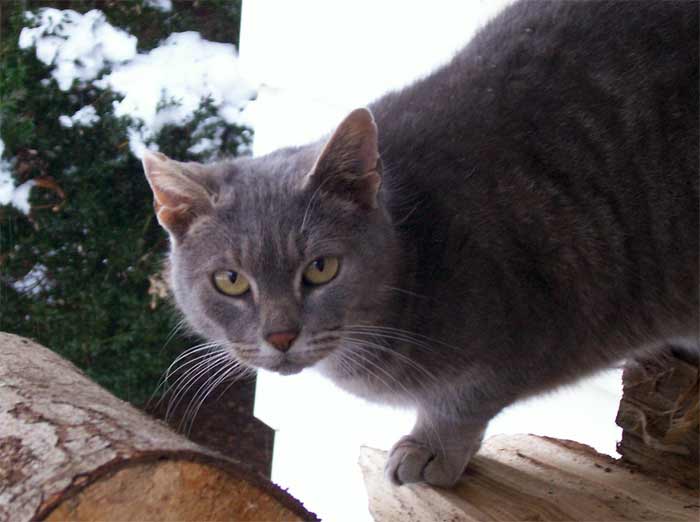
Do not take feral cats to shelters.
Let feral cats live their lives!
Feral cats are territorial and do not like to be moved to new locations. They become attached to their surroundings and develop routines. When circumstances cause disruptions in their lives, feral cats become agitated, acting more nervous than usual. If at all possible, allow a feral cat to stay where it feels at home.
Cats like to stay put.
Never move a feral cat from one colony to another unless absolutely necessary. Moving causes fear, fighting, and horrible stress for every cat involved.
Also, do not catch a feral cat and then take it to a shelter. The feral cat is not adoptable and will most likely be put to death within a few days.
Some stray cats are partially socialized.
They might have lived indoors and been mistreated or abandoned when young. These types of stray cats may take food from your hand or let you pat the top of their head, but will run if you try to pick them up.
Partially socialized cats usually freak out if you bring them indoors or put them in a cage. Every cat is unique with varying degrees of socialization skills. Even a completely tame cat will act feral in scary circumstances!
Start socializing kittens as soon as their eyes open.
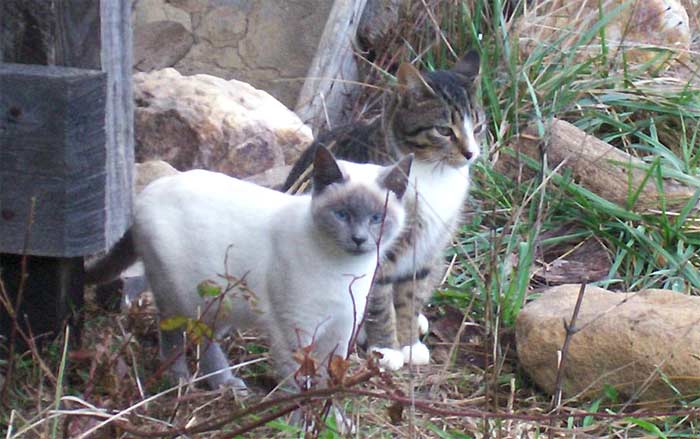
Sun Lee and Brad are shy cats, but they posed for a photo.
Good kitties!
When feral cats give birth to kittens, the kittens must be socialized within the first month of life (or they will also become feral, too). It is best to start taming kittens when their eyes open at around two weeks old. Socializing skills must be taught before the kittens reach eight weeks old. After that, the job is much, much harder.
Feral cats and even their kittens are not adoptable because they bite and scratch. They are not happy living with people, and do not like to be indoors. They probably think we are big monsters! That is why it is important to socialize the kittens. Hopefully the socialized kittens find happy homes with a human family.
Feral cats are different from pet cats.
Just like humans, cats have different personalities and lifestyles. I have been privileged to become acquainted with all kinds of cats. I have been responsible for pet cats, indoor cats, outdoor cats, and skittish cats that are only after one thing (more food), but will tolerate petting.
Feral cats are different. They run when they see me coming! They are not socialized in the least bit, and will only eat when I am at a distance. You can not whisper to these cats or coax them into your lap!
Feral cats are not a threat to humans.
Feral cats can live happy and healthy lives, but they need assistance to do so. These animals are where they are because of negligent humans. It is never fair to label a feral cat as a pest or threat. They need help, but they do not need to be kept in cages, shot, poisoned, or euthanized!
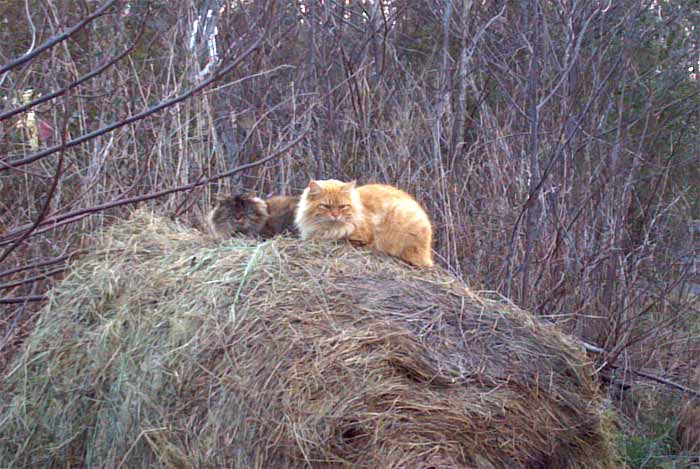
Feral cats can live a long, healthy life when managed properly.
Trap, neuter, and release programs for feral cat populations
In the United States , feral cats are often helped by humane societies and other animal welfare organizations. Food, water, population control, and rabies shots are the main concerns when trying to help a feral cat (or a feral cat colony).
The best way to help a feral cat colony is to trap, neuter, and release every cat in the colony. This is known in the industry as TNR.
When cats are trapped and taken in for surgery, they are asleep long enough for a veterinarian to give them an exam. The cats are then (hopefully) wormed, treated for fleas, checked for other health problems, and given rabies shots. Some might even get micro-chipped and dental care!
TNR staff members are fast workers.
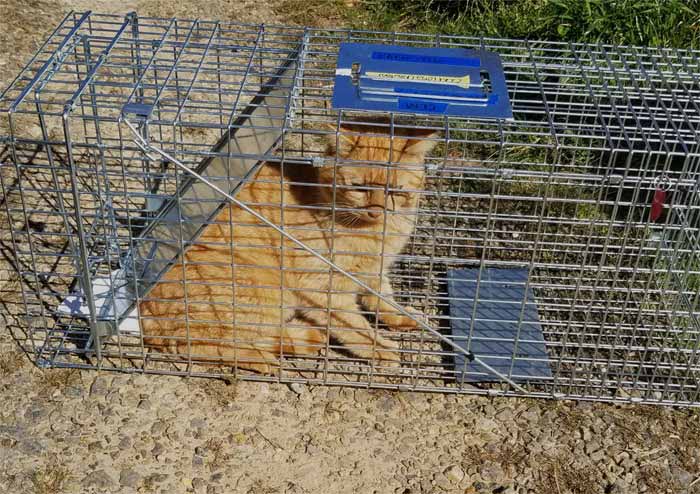
Scrapper is glad to get home! After I get his picture, I will let this handsome
male go free.
Several teams might be out trapping in different locations to get enough for “neuter and spay day”. The veterinarians may see over a hundred feral cats in eight hours! The clinics keep the feral cats overnight, and then the TNR staff members deliver them back to where they were caught.
A day after surgery, the “fixed” cats are very happy to return home. When the cages are opened, the cats disappear into their favorite hiding spots. Surgery doesn't seem to bother them a bit! If you want to more about how cats feel about trapping, read Sun Lee's story.
We have been managing a feral cat colony since 2001.
Cats have come and gone, new ones appear every year, and somehow kittens arrive every spring. I don't know where the first one came from, but I imagine the colony started decades ago with one pregnant female.
She was probably dumped and took refuge here on the farm.
More and more kittens are born.
Some of feral cats are killed by hawks, foxes, skunks, dogs, and snakes. Others die from sickness and disease, but many survive. This cycle continues season after season.
For a long time, we had around a dozen cats in the colony at any one time. Once I arrived in 2001, we were able to get the females spayed and most of the tomcats neutered. The population stayed fairly stable for twenty years even though pregnant females and strays slipped in occasionally.
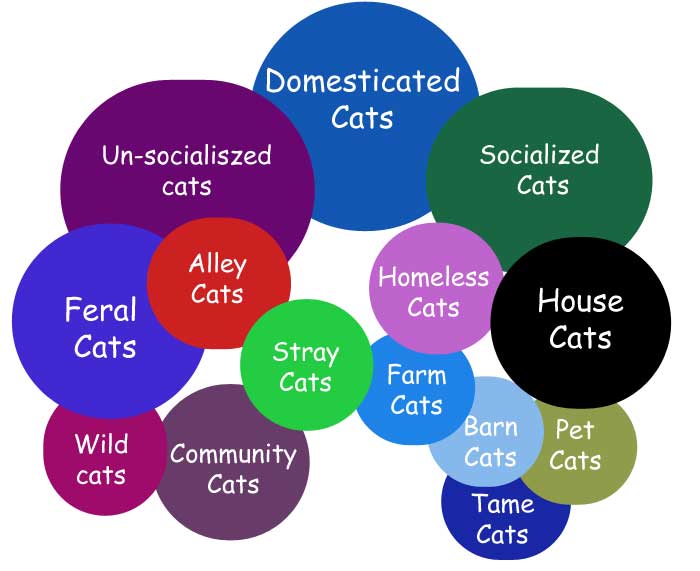
Cats can be socialized or un-socialized and everywhere in between. Often the
labels overlap. Graphic by Janice Boling
Every year new cats arrive.
Sometimes the new one are semi-socialized, but usually they are feral. Some were probably abused, some are damaged in some way. They may be missing an eye, or have half of a tail. They come in all colors, all breeds, and all sizes from fat and healthy to skin and bones.
Not all of them were dumped in our driveway. Being near the Chattahoochee National Forest, the Appalachian Trail, and several wildlife areas, I assume many of them came in from the woods. I figure people dump on dirt roads because there aren't any cameras or prying eyes!
Even feral cats born away from humans crave human interaction and will try to find a homestead or village to call home. Domesticated cats may act wild, but they are not wild animals and were evolved to live near people.
We made pets out of many of these strays, and they became our babies. Of course, the feral cats never offered to be pets so we just let them be.
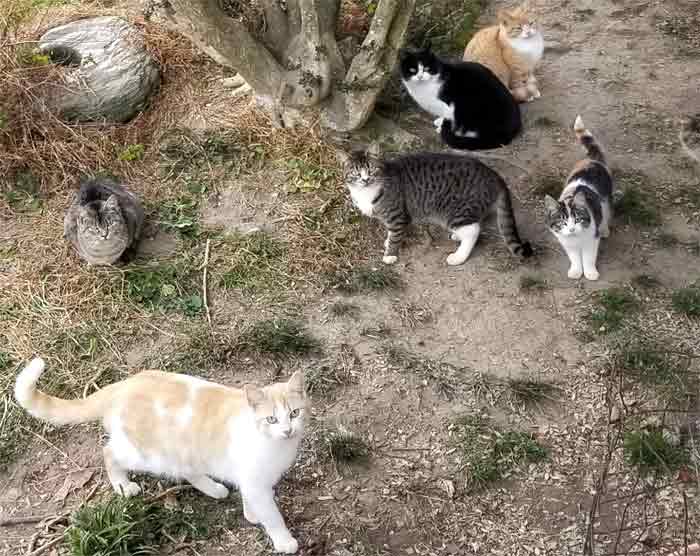
These feral cats are healthy and happy, but will not let me get near enough
to touch.
Cat population explosion 2020
Sometime during 2020, things changed dramatically. Suddenly new cats appeared almost weekly. I think the pandemic along with the spring shut down, a loss of jobs, and rising housing costs in our area, caused a huge increase in abandoned pets. Many ended up on our farm!
Large males arrived first.
They were mostly strays with plenty of old battle scars. Most were terrified of humans and each other. Some were limping and one was missing most of his front teeth. Males don't usually stay too long. They usually come and go, but in 2020 most of them stayed!
Pregnant females also appeared.
One time we got up on Sunday morning, opened the back door, and found a mother cat with four kittens. There was a bag of food with them, but no note. Since these five cats were all friendly and socialized, we were able to find them homes.
Some pregnant females that came to stay were completely feral. We were able to catch a few of their kittens, tame them up, and find them homes. Others hid in the walls, and were impossible to catch. (At age 66, I am not as spry as I used to be and can't crawl around in the loft or under farm equipment.) By 2022, we had more cats than we could feed! Thank God the TNR people came to help!
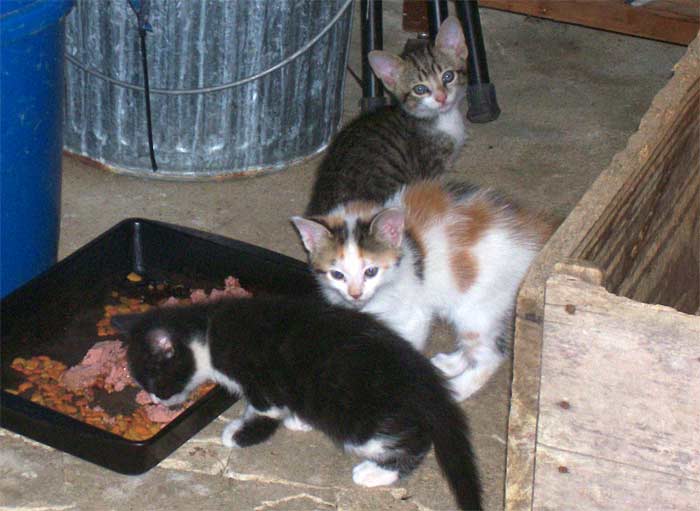
These kittens were dumped. Since they were socialized, we were able to find
them good homes.
Rural areas are not dumping grounds for unwanted pets.
People always see farms as perfect dumping grounds. They see the big hay barns, happy cows in the pastures, and a lonely dirt road. They think, “We can dump our cat here. It will have a good home and no one will see us do it.”
On our farm, cats happen to have it good because we are animal lovers. But just imagine if there were hunting dogs that killed cats. Or what if there were baited traps set out for rats? The poor abandoned animal could get torn apart by dogs, suffer an agonizing death by poison, or get shot by in irritated farmer.
Many think it's OK to dump in the woods. Well, let me tell you this! It is a cruel fate to be dumped in a forest. These dumped animals, unless they find a caring human, are going to starve, be run over, freeze to death, or become prey.
Dumping animals is illegal.
People should consider the consequences before dumping a pet! Cameras are not just on phones. They are everywhere. Cameras are easily hid in trees and on fence posts. If you are caught dumping an animal, you could be fined and prosecuted to the fullest.
You never know what's going to happen when you dump a pet. Just because a place looks like a good home for a cat (or dog), does not mean that it is. Dumping causes pain and suffering so do not do it! There is always a better solution.
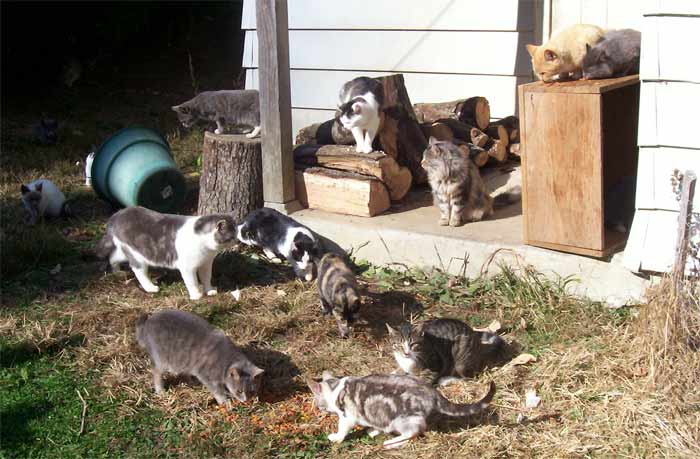
There are twelve feral cats in this photo. It's impossible to get them all
in one shot.
Feral farm cats
Since the feral cats around here live on a cattle farm, they have comfortable shelters in the hay barns. They have a creek with clean water and plenty to eat. The feral cats on our farm do us a service. They keep rats, mice, and snakes away, which is worth the price of cat food.
A world full of feral cats
Some feral cats don't have a nice warm barn or two humans giving them Meow Mix twice a day. They live in cities, towns, sub-divisions, outlying areas, forests, deserts, in the mountains, on the plains, and at the seashore. Feral cats are found in every country and on every continent except Antarctica.
Whether known as stray cats, alley cats, community cats, wild cats, un-socialized cats, homeless cats, or feral cats, they are God's creatures. All of them deserve food, water, shelter, and medical care!
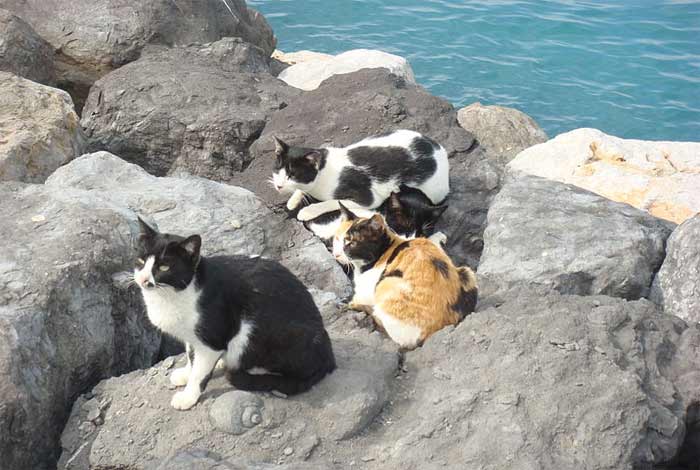
Photo of feral cats at the beach provided by Wiki Commons
Feral cats fend for themselves.
Feral cats are sometimes solitary, but will usually form a colony or community. It is possible for feral cats to live completely apart from humans, but these isolated cats have a short life span of only two years. They starve, freeze, get eaten by predators, succumb to disease, and get run over by cars.
A lot of feral cats have human colony managers that feed them and provide medical care. These are the lucky feral cats. Their life expectancy is about the same as a domesticated indoor/outdoor cat. Feral cats have a place and can co-exist peacefully with us. Give them a chance!
Are feral cats dangerous?
No! Feral cats are not dangerous unless you corner them. Then they might bite and scratch just like any animal that is frightened.
Of course, rabies is always a danger. That is why feral cats need to be trapped, neutered, vetted, and released after getting shots!
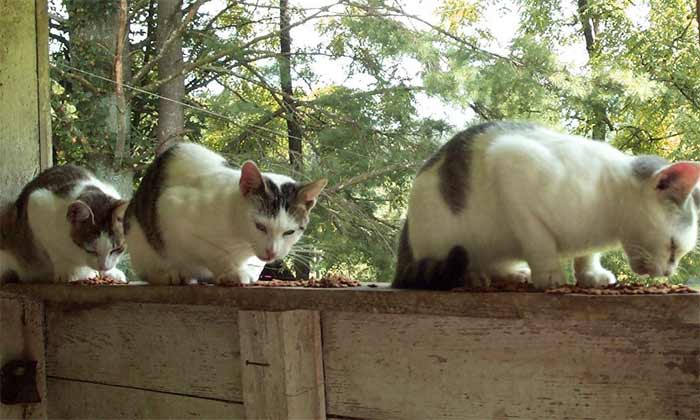
These three cats look like sisters. I call them Sissy, Sally, and Susie.
How can I help feral cats?
Feral cats are often hungry and thirsty. The first thing you can do to help a feral cat is to offer it food and water. Put the food and water bowls in a place where the cat feels the most comfortable, such as outdoors near some bushes or on the edge of a patio.
Give feral cats shelter from the cold.
If it is winter, provide an insulated “house” so that the cat can stay warm at night when temperatures drop below freezing. Insulated cat houses can be made at home out of Styrofoam coolers, purchased at your favorite pet store, or ordered online.
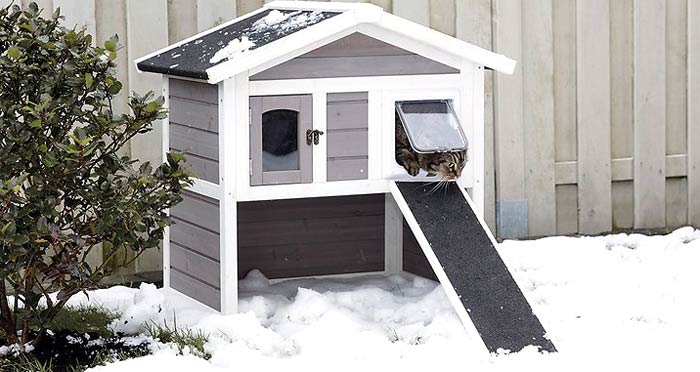
Photo from Chewy.com
Find a trap, neuter, and release program in your area.
Try to get help from professionals if you are not able to get feral cats in your neighborhood vetted. Your local humane society or animal shelter can point you in the right direction. Hopefully there is a TNR program that will help with trapping and setting up veterinarian appointments.
Remember that one fertile female can have kittens at an alarming rate. Before you know it, one or two will turn into a colony of twenty or more.
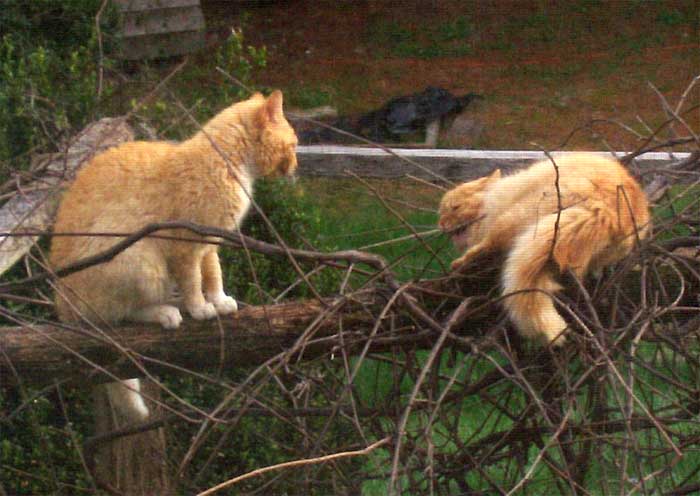
Feral cats often fight over territory. Neutering the males helps solve this
problem.
Do you want to help feral cats?
Volunteer at your local TNR clinic or humane society! Even a few hours a week can make a difference. You can also foster kittens or feed a feral cat colony that doesn't have a manager. Look for opportunities to get involved and you will find them.
Giving feral cats a better life
Once a feral cat has been vetted, it will usually be released where it was caught. The “fixed” feral cat will still need food, water, and shelter.
If you are providing the necessities like food and shelter for a feral cat, go ahead and try to be friends with it. It is worth a try.
Give the feral cat a name. Take its picture. Talk to it in a soothing voice. Offer it treats. Over time, a young feral cat will probably become friendly. Older feral cats might never get completely comfortable in your presence, but at least you will know you are doing what you can to give them a better life.
Feral cats in the arts
Take a look at this short stop-motion, animated film called "Hulong Meow". It is about a day in the life of a feral city cat.
How can you tell if a cat is feral?
You can tell if a cat is feral by how it acts. A feral cat will run if you get too close. They are afraid of humans and are not at all friendly.
Feral cats do not seek human companionship, but do tend to live near humans. Feral cats usually take up residence in places where there is a food supply such as garbage cans, dumps, compost piles, and livestock feed bins.
These cats do not have owners, although they often have humans that feed them cat food. Some even have colony managers that help them get medical care.
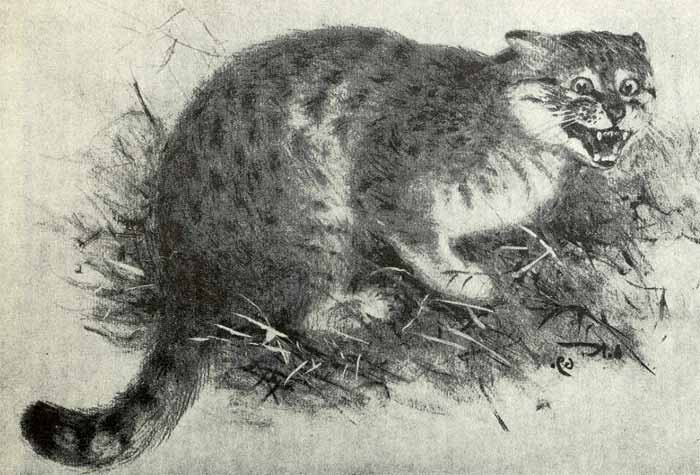
A feral cat might hiss and bare its teeth if you get too close. Drawing
of hissing cat by Wiki Commons.
Feral cats will hiss, scratch, and bite if cornered. You do not want to mess with a terrified, feral cat unless you know what you are doing.
Even when secured inside an appropriate trap, feral cats can reach out and scratch anyone that gets near. When a feral cat is in a cage, please cover it with a thin sheet. A breathable cover really helps calm a frightened animal.
Feral cats might have a tipped ear.
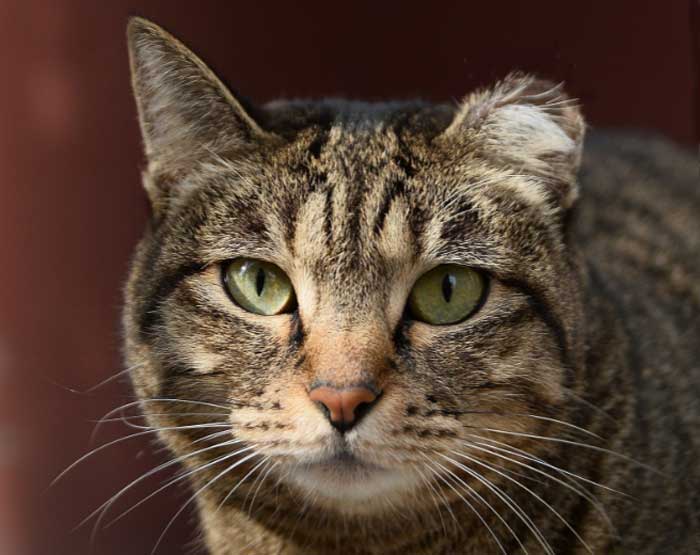
The vet got a little carried away tipping this cat's ear. Usually they are
not so noticeable. Photo
of cat with tipped ear by Wiki Commons.
You usually have to look closely. When you see a cat with the tip of its ear cut straight across, it has probably been trapped, neutered or spayed, and released. This clean cut heals in less than 48 hours and does not cause the cat any discomfort. Trap, neuter, and release programs are a great solution for feral cats and feral cat colonies.
While the feral cats are at the TNR (trap, neuter, release) clinic, they might also get rabies shots, flea medications, micro-chipped, wormed, and other medical care depending on available funding.
The tip of the ear is snipped off as a sign that the cat has been caught and “fixed”. TNR is a wonderful service and all towns should support these type programs.
Feral cats are anti-social.
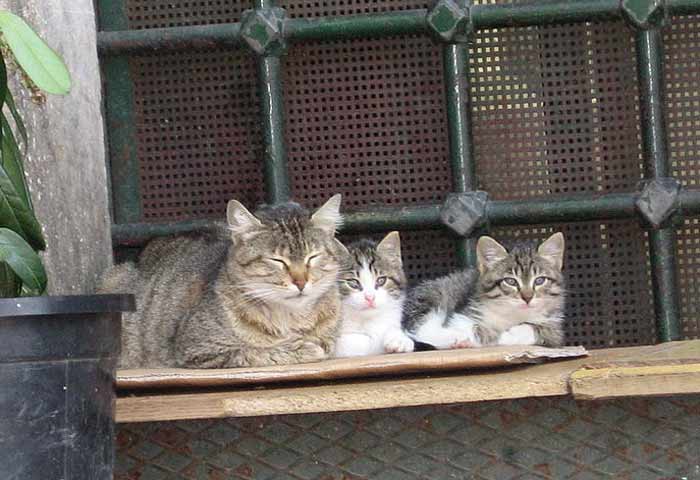
I sure hope these kittens get some human affection while they are little. Photo
of cat with kittens by Wiki Commons
Feral cats have not been socialized. If they are born and live the early weeks of their lives without human interaction, they become un-socialized cats. If a cat is not petted and handled by humans at a young age, it will have a hard time adjusting to any type of human affection later on in its life.
Kittens need human interaction or they become feral.
There is a small window when cats can easily become socialized. After they are six weeks old it becomes harder and harder. Of course, all cats have unique personalities and some are naturally friendly. A naturally friendly cat might be partially socialized at any age, while a naturally aloof cat might never allow a human to get close.
Feral cats come from domesticated stock but they act wild.

All cats hiss, scratch, and bite if they are threatened. Photo
of hissing cat by Wiki Commons
Cats are not meant to live a wild life. If they are forced to do so, their life spans are short. Feral cats in the wild only live around two years. They starve, freeze, and are eaten by predators. Many get run over in traffic or succumb to disease. Sometimes they are poisoned or shot by humans. When caught and taken into shelters, they are usually euthanized within a few days.
Feral cats are not adoptable.
Feral cats do not want to live indoors. It makes them very uncomfortable to be inside an enclosed building. They do not like to be in close proximity to humans. You can't pet a feral cat or pick one up!
Only in rare instances do feral cats tame up enough to be comfortable around people. It is best to let feral cats live their lives outdoors in whatever territory they call home.
Feral cats do not like to change locations.
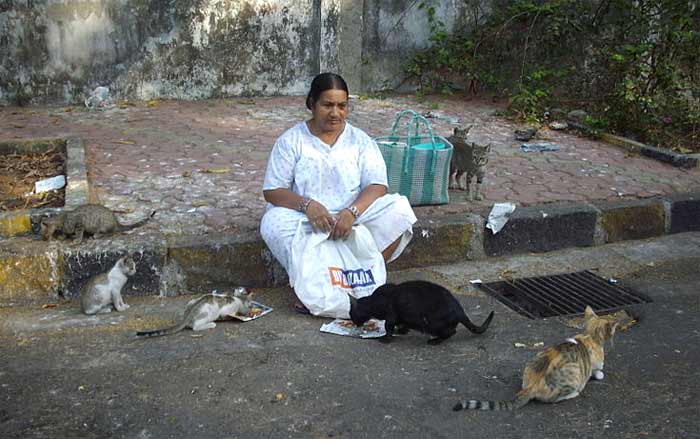
This lady feed the strays of Mumbai everyday. Photo
of city cats by Wiki Commons.
Cats have their own territories. They do not like to be moved to new places. Cats love routines. They do not like surprises. I am sure it would be terrifying to be trapped and then released in a strange place. I wouldn't like it and neither do cats.
The only time feral cats should be moved to a new location is to ensure their safety. If bulldozers are arriving to start new construction, then yes, cats living there must be moved. Hopefully they will get a new home where they can feel safe and secure. Often farms, ranches, stables, and other agricultural operations will take them. It is worth a try.
Be careful not to confuse feral cats with lost or homeless cats.
Sometimes stray cats are not feral at all. They might just be hungry, cold, and terrified.
In unfamiliar situations, domesticated pet cats will act feral. Shelters and animal sanctuaries should be careful when labeling a cat feral or tame at first meeting.
Sometimes it takes a while (two or three days) for a cat to calm down enough to show its true personality traits. Shelter and veterinarian staff members should always give an animal time to relax before passing judgments.
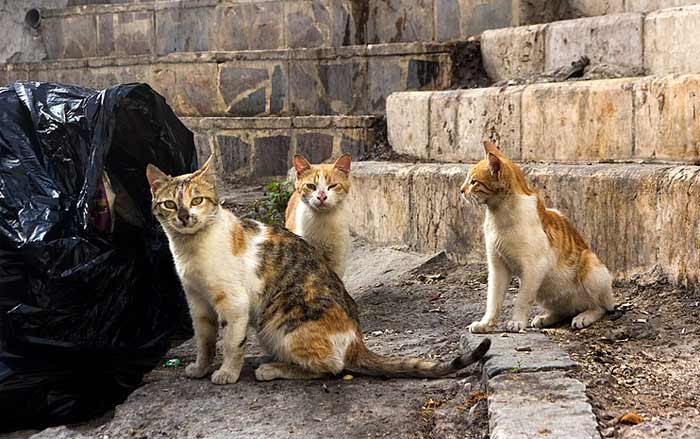
These city cats will be in trouble if they keep getting into the garbage. Photo of stray cats by Wiki Commons.
Are stray cats and feral cats the same?
Not really. Feral cat are un-socialized cats that have usually settled in some sort of permanent home, whether in a colony or alone.
Stray cats don't have a home and are still looking. Stray cats might be un-socialized or socialized depending on if they have ever lived as pets or not.
An abandoned “stray” is not feral but could become feral as the years goes by. Cats can lose socialization skills in time if they are not around humans.
All homeless cats are not feral. Some homeless cats are as tame as any other domesticated house cat. The label of “feral cat” depends on if the cat has socialization skills or not. It all depends on how the cat acts.
What are free roaming cats?
Free roaming cats are pets that are allowed to go outside and explore the neighborhood. They are also called indoor outdoor cats although some indoor outdoor cats have fenced yards or runs and are not really free-roamers. If a cat is not allowed to roam at will, then it is not a free roaming cat.
What are community cats?
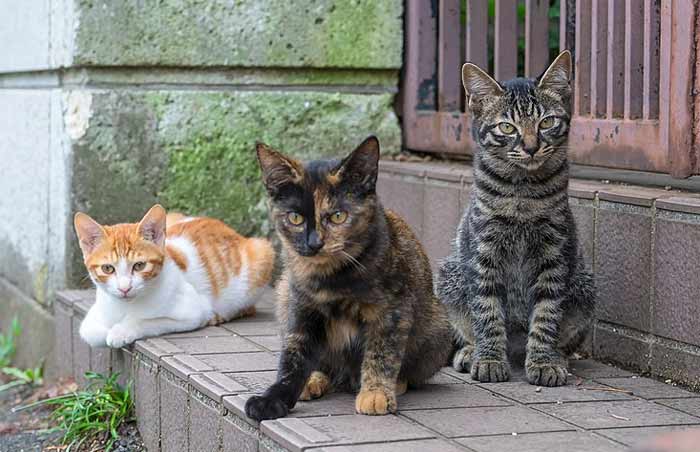
These feral community cats are fed regularly by concerned citizens. Photo
of community cats by Wiki Commons.
Community cats might be feral cats, strays, or free roamers. They live in a neighborhood, village, or town where people take care of them by providing food, water, and medical care. Most community cats are loved, well-cared for, and healthy.
Some community cats are more like strays. They are under-appreciated and might even be considered pests. These cats should be evaluated for socialization skills so that the tame ones can be adopted into loving homes. Hopefully the others can stay where they are at or be relocated to a suitable feral cat colony.
Can feral cats be useful?
Yes! Feral cats help keep the mice populations down. They also kill rats that carry disease. Many farms, ranches, chicken houses, and other agricultural operations depend on cats to keep rodents in check. By managing a feral cat colony, the owners do not have to put out poisons or worry about setting traps for mice. In situations like this, feral cats are valuable assets.
Thanks for reading my feral cat colony blog. Jan.
* Important note - it is illegal to shoot or intentionally harm a domesticated animal (which includes feral cats). There is always a better solution. Please contact one of the resources below for more information.
The best resources to find out more about feral cats:
https://www.alleycat.org/
https://pets.webmd.com/cats/helping-stray-and-feral-cats
https://en.wikipedia.org/wiki/Feral_cat
https://www.humanesociety.org/resources/outdoor-cats-faq
https://www.aspca.org/about-us/aspca-policy-and-position-statements/position-statement-community-cats-and-community-cat
______
© 2022 - 2024 by Janice Boling - all rights reserved.